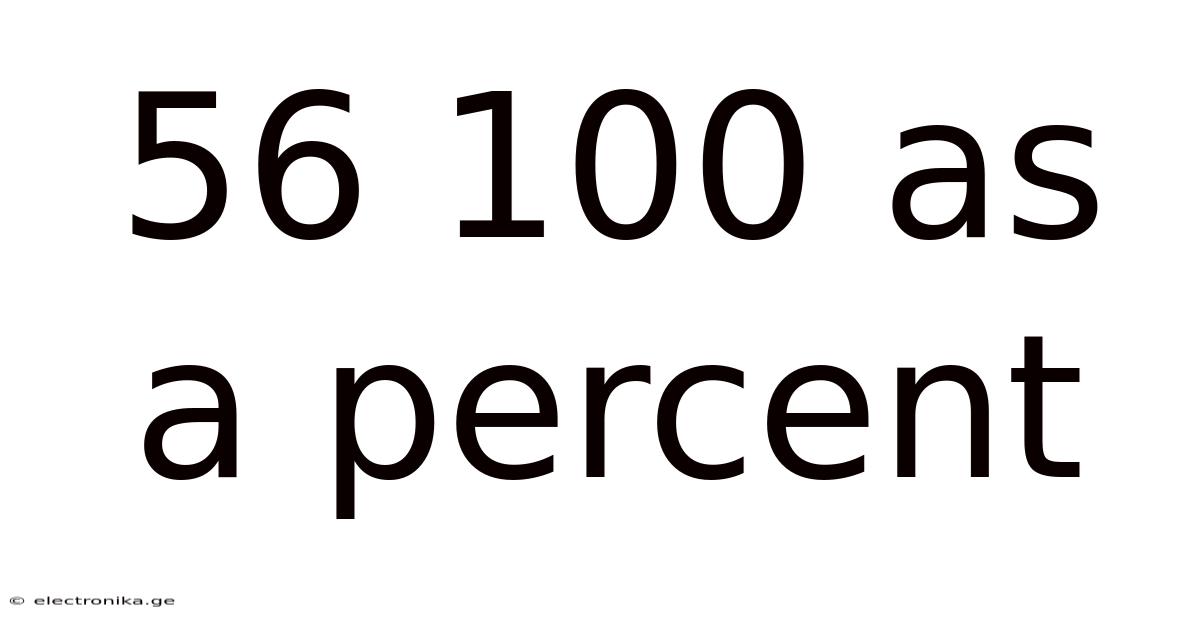56 100 As A Percent
electronika
Sep 25, 2025 · 4 min read

Table of Contents
56 out of 100 as a Percent: Understanding Percentages and Their Applications
Understanding percentages is a fundamental skill in mathematics with widespread applications in everyday life, from calculating discounts and taxes to understanding statistics and financial reports. This article will delve into the specifics of expressing 56 out of 100 as a percentage, exploring the underlying concepts and demonstrating various methods of calculation. We will also examine real-world scenarios where this type of percentage calculation proves invaluable.
Introduction: What are Percentages?
A percentage is a way of expressing a number as a fraction of 100. The word "percent" literally means "per hundred" or "out of 100". It's a convenient way to represent proportions and comparisons. For instance, scoring 80 out of 100 on a test can be expressed as 80%. This means you achieved 80 parts out of a possible 100 parts. The symbol "%" is used to represent percentages.
Calculating 56 out of 100 as a Percentage: The Simple Method
The simplest way to determine what percentage 56 out of 100 represents is to directly apply the definition of percentage. Since a percentage is a fraction of 100, and we already have a fraction where the denominator is 100, the numerator directly represents the percentage.
Therefore, 56 out of 100 is equal to 56%.
Method 2: Using the Formula
A more general approach, applicable to any fraction, involves using the percentage formula:
Percentage = (Part / Whole) x 100%
In this case:
- Part = 56
- Whole = 100
Substituting these values into the formula:
Percentage = (56 / 100) x 100% = 56%
This formula is crucial for calculating percentages when the denominator isn't 100.
Method 3: Decimal Conversion
Another method involves converting the fraction to a decimal and then multiplying by 100%.
- Convert the fraction 56/100 to a decimal: 56/100 = 0.56
- Multiply the decimal by 100%: 0.56 x 100% = 56%
This approach highlights the relationship between decimals and percentages: moving the decimal point two places to the right is equivalent to multiplying by 100%.
Beyond the Basics: Working with Different Denominators
While the example of 56 out of 100 is straightforward, calculating percentages often involves fractions with denominators other than 100. Let's explore how the percentage formula works in those cases.
Example 1: 14 out of 20
To find the percentage representation of 14 out of 20, we apply the formula:
Percentage = (14 / 20) x 100% = 0.7 x 100% = 70%
Example 2: 27 out of 75
For 27 out of 75:
Percentage = (27 / 75) x 100% = 0.36 x 100% = 36%
These examples demonstrate the flexibility of the percentage formula. It allows you to calculate percentages from any fraction, regardless of the denominator.
Real-World Applications of Percentage Calculations
The ability to calculate percentages is a vital skill with numerous real-world applications, including:
-
Finance: Calculating interest rates, discounts, taxes, profit margins, and investment returns. Understanding percentage changes in stock prices or savings account balances is crucial for financial planning.
-
Statistics: Representing data in a readily understandable format. For example, expressing survey results, poll data, or the percentage of a population with a specific characteristic.
-
Science: Expressing experimental results, concentration of solutions, or changes in quantities.
-
Retail: Calculating discounts, sales tax, and markups. Understanding percentage discounts helps consumers make informed purchasing decisions.
-
Education: Grading systems often use percentages to represent student performance. Understanding your percentage score on a test or assignment is crucial for tracking academic progress.
Frequently Asked Questions (FAQ)
-
Q: What if the number isn't easily divisible by 100?
A: Use the general percentage formula: (Part/Whole) x 100%. You can use a calculator to perform the division.
-
Q: How can I calculate percentage increase or decrease?
A: Percentage increase/decrease is calculated as [(New Value - Old Value) / Old Value] x 100%. A positive result indicates an increase, while a negative result indicates a decrease.
-
Q: What are some common percentage equivalents to memorize?
A: Memorizing common fractions and their percentage equivalents (e.g., 1/2 = 50%, 1/4 = 25%, 1/5 = 20%, 1/10 = 10%) can speed up calculations.
-
Q: How can I use percentages to compare different quantities?
A: Percentages provide a standardized way to compare quantities with different totals. For example, comparing the percentage of students who passed a test in two different classes allows for a meaningful comparison, even if the class sizes are different.
Conclusion: Mastering Percentages for Success
Understanding percentages is a fundamental mathematical skill with broad practical applications across various aspects of life. This article has explored different methods for calculating percentages, particularly focusing on expressing 56 out of 100 as a percentage (which is 56%). While the example of 56 out of 100 provides a simple illustration, the underlying principles and formulas are applicable to a wide range of scenarios. Mastering percentage calculations empowers you to analyze data, make informed decisions, and successfully navigate numerous situations requiring quantitative analysis. By understanding the core concepts and practicing the methods described here, you'll enhance your mathematical skills and gain a valuable tool for everyday problem-solving. Remember, practice is key to mastering any mathematical concept, so continue practicing different percentage problems to solidify your understanding.
Latest Posts
Related Post
Thank you for visiting our website which covers about 56 100 As A Percent . We hope the information provided has been useful to you. Feel free to contact us if you have any questions or need further assistance. See you next time and don't miss to bookmark.